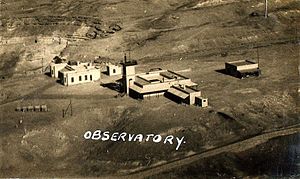National Research Institute of Astronomy and Geophysics
|
المعهد القومي للبحوث الفلكية والجيوفيزيقية National Research Institute of Astronomy and Geophysics (NRIAG) |
|
|---|---|
|
The Helwan Observatory in the 1900s |
|
| founding | 1960 (organization) |
| Consist | Since the antiquity |
| IAU code | 087 |
| height | 67 m |
| Coordinates | 29 ° 51 '31 " N , 30 ° 15' 5.5" E |
| place | Helwan |
The National Research Institute of Astronomy and Geophysics (NRIAG; Arabic المعهد القومي للبحوث الفلكية والجيوفيزيقية, DMG al-maʿhad al-qaumī li-l-buḥūṯ al-falakiyya wa-l-ǧiyūfīzīqiyya ; Name from 1986, before that from 1960 Helwan Institute of Astronomy and Geophysics HIAG, 1946 Royal [Egypt] Observatory , 1903 Helwan Khedivial Observatory 'Royal Observatory') is a state research institute for astronomy and geophysics in Helwan near Cairo, Egypt .
history
The first modern observatory was operated in Bulaq in western Cairo from 1840 to 1860 (Boulac Observatory) .
In 1865 an astronomical and geophysical observatory was built in Abbasya , in the east of Cairo. From 1874 a passage instrument (meridian passage telescope) was set up here, which was used to determine the time. The increasing light pollution in the city and the trams supplied with direct current made observational astronomy and the measurement of geomagnetic fields no longer useful at the turn of the century.
Helwan Observatory
In 1903 the observatory was relocated to Helwan, then a village with 5000 inhabitants, 30 km south of Cairo. In 1905 Reynolds gave it a 75 cm telescope, the first large telescope in Africa. In 1948 the observatory got a 74-inch reflector from Grubb Parsons . The Helwan Solar Station and Artificial Satellite Stations for satellite tracking were also set up here in 1957 .
This observatory is listed on the Outstanding Astronomical Heritage list of the International Astronomical Union , and has also been proposed as a UNESCO World Heritage Site since 2010 (tentative list).
Kottamia Astronomical Observatory
Due to the increasing light pollution in Helwan 1963 the built a new Observatory in Kottamia ( 29 ° 55 '48 " N , 31 ° 49' 30" O ). This is equipped with a large reflector telescope , identical to those in the Mount Stromlo Observatory , the Observatoire de Haute-Provence , the Okayama Observatory , the David Dunlap Observatory and the Radcliffe Telescope and has a diameter of 188 cm. This was modernized in 1997.
Helwan / Misallat Geomagnetic Observatory
After the tram was extended to Helwan in the 1950s, the geomagnetic observatory also had to be relocated because of the disruptions. It was 1960 in Misallat ( 29 ° 30 '54 " N , 30 ° 53' 30" O ), built 70 km southwest of Cairo, new.
Research and service
The most important task of the institution is the observation of the new light (first sighting of the fine crescent moon after the new moon), the basis of the Islamic calendar and the dates of Ramadan , and the calculation of the prayer times including the direction to Mecca, which is important for the prayers (salāt), as a standard for the whole Arab world.
In 1909 Halley's Comet was observed here for the first time worldwide . 1922 the Jupiter moon VIII ( Pasiphae ), 1930 one participated in the discovery of Pluto,
In addition, numerous galaxies ( nebulae ) were photographed and mapped and played a key role in the modern classification of galaxies.
In addition, the observatory was responsible for the time service until 1961, for weather data and forecast until 1944, and also housed the Egyptian meter standard (was then also spent at the Institute for Meteorology).
The Museum of Astronomy and Geophysics is also located in Helwan .
Web links
![]() Map with all coordinates: OSM | WikiMap
Map with all coordinates: OSM | WikiMap
- Entry in the tentative list of UNESCO (English) - detailed description
- Homepage (English, down 2019)
Individual evidence
- ↑ a b Weblink UNESCO, section Helwan Observatory in post-war period .
- ↑ a b Weblink UNESCO, Section Modern Astronomy in Egypt .
- ↑ a b c d Weblink UNESCO, Section National Services and Public Outreach .
- ↑ a b Weblink UNESCO, section The story of the 30 inch telescope at Helwan .
- ↑ Entry in UNESCO: astronomicalheritage.net .
- ↑ HA Deebes, W. Heileman: Sun, Sand and Stars . on saao.ac.za - Modernization of the Kottamia Observatory (English).
- ↑ a b Weblink UNESCO, Section International Services .
- ↑ a b c d Weblink UNESCO, section Historical Observations at Helwan .
